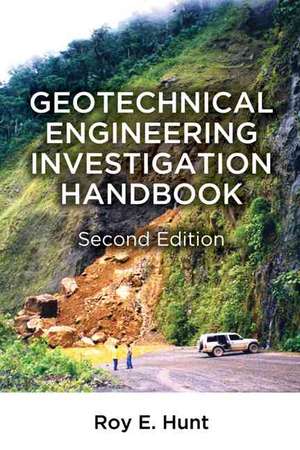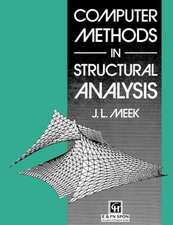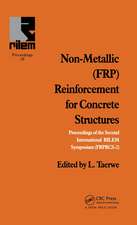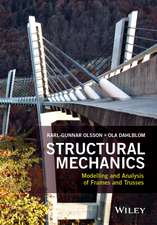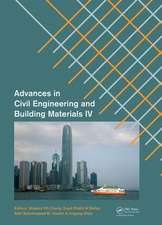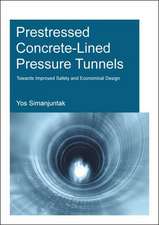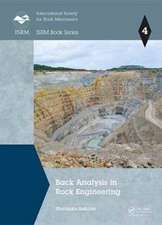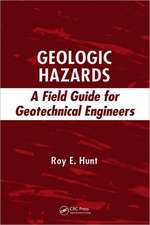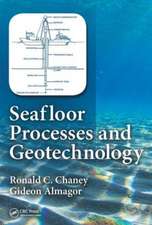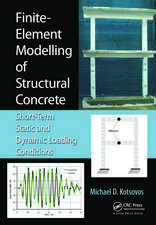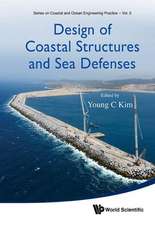Geotechnical Engineering Investigation Handbook
Autor Roy E. Hunten Limba Engleză Hardback – 12 apr 2005
• Global positioning systems (GPS)
• Geophysical exploration
• Cone penetrometer testing
• Earthquake studies
• Digitizing of data recording and retrieval
• Field and laboratory testing and instrumentation
• Use of the Internet for data retrieval
The Geotechnical Engineering Investigation Handbook, Second Edition is a comprehensive guide to a complete investigation: study to predict geologic conditions; test-boring procedures; various geophysical methods and when each is appropriate; various methods to determine engineering properties of materials, both laboratory-based and in situ; and formulating design criteria based on the results of the analysis. The author relies on his 50+ years of professional experience, emphasizing identification and description of the elements of the geologic environment, the data required for analysis and design of the engineering works, and procuring the data.
By using a practical approach to problem solving, this book helps engineers consider geological phenomena in terms of the degree of their hazard and the potential risk of their occurrence.
Preț: 1601.01 lei
Preț vechi: 1952.45 lei
-18% Nou
306.35€ • 320.71$ • 253.49£
Carte tipărită la comandă
Livrare economică 05-19 aprilie
Specificații
ISBN-10: 0849321824
Pagini: 1102
Ilustrații: 774 b/w images, 33 color images, 187 tables and 250 halftones
Dimensiuni: 171 x 241 x 59 mm
Greutate: 2.07 kg
Ediția:2
Editura: CRC Press
Colecția CRC Press
Public țintă
ProfessionalCuprins
Foreword
Preface
Introduction
Basic Considerations
Scope
Geotechnical Investigation: Objectives, Stages, Scope, and Planning
Investigation Methods and Procedures
Exploration
Introduction
Surface Mapping
Subsurface Exploration
Recovery of Samples and Cores
References
Further Reading
Measurement of Properties
Introduction
Basic and Index Properties
Hydraulic Properties (Permeability)
Rupture Strength
Deformation Without Rupture
Typical Values of Basic, Index, and Engineering Properties
References
Further Reading
Field Instrumentation
Introduction
Surface Movements
Subsurface Deformations
In Situ Pressures and Stresses
Instrumentation Arrays for Typical Problems
References
Further Reading
Catalogs
Characteristics of Geologic Materials and Formations
Rock and Soil: Identification and Classification
Introduction
Rock
Soils
References
Further Reading
Rock-Mass Characteristics
Introduction
Original Rock-Mass Forms
Deformation by Folding
Jointing
Faults
Residual Stresses
Alteration of Rock
References
Further Reading
Soil Formations: Geologic Classes and Characteristics
Introduction
Residual Soils
Colluvial Deposits
Alluvial Deposits
Eolian Deposits
Glacial Deposits
Secondary Deposits
Pedological Soils and Plant Indicators
References
Further Reading
Water: Surface and Subsurface
Introduction
Surface Water
Subsurface Water (Groundwater)
Groundwater and Seepage Control
Environmental Conservation
References
Further Reading
The Geologic Hazards
Landslides and Other Slope Failures
Introduction
Slope Failure Form Characteristics
Assessment of Slopes
Treatment of Slopes
Investigation: A Review
References
Further Reading
Ground Subsidence, Collapse, and Heave
Introduction
Groundwater and Oil Extraction
Subsurface Mining
Solution of Rock
Soil Subsidence and Collapse
Heave in Soil and Rock
References
Further Reading
Earthquakes
Introduction
Earthquake Elements
Surface Effects on the Geologic Environment
Earthquake-Resistant Design: An Overview
Investigation: Important Structures in High-Hazard Areas
References
Bibliography
Appendices
Appendix A: The Earth and Geologic History
Significance to the Engineer
The Earth
Global Tectonics
Geologic History
References
Further Reading
Appendix B: USGS Quads and Aerial Photographs in Book
Appendix C: Conversion Tables
Appendix D: Symbols
Appendix E: Engineering Properties of Geologic Materials: Data and Correlations
Index
Color Plates Section
Recenzii
—Stuart Mills, Materials World, Vol. 14, No. 9, September 2006
"Whoever reads this book will never approach geotechnical exploration in the same way again. Nowhere else has it been made so evident that all boundaries among engineering geology, geophysics, rock mechanics, soil mechanics, geohydrology, seismology, and a host of other disciplines are meaningless; that contributions to the solution of geotechnical problems may come from any or all of these sources; or that the practitioner who holds too narrowly to a specialty is likely to overlook knowledge that could be of the greatest benefit to him in reaching a proper judgment. If for no other reason than to appreciate the breadth of geotechnics and to escape from the trap of too narrow a perspective, this book should be read."
—Dr. Ralph B. Peck, from the Foreword to the First Edition
“This is pure gold in ‘nuts and bolts’ of the profession. Hunt’s title and prefatory materials proclaim that this is a book written primarily for geotechnical engineers, yet any astute engineering geologist will not only understand its content and impact, but will also be able to ‘read between the line’ and learn more of the perspective of each topic. …The book content will be highly valuable throughout a project, from planning through conduct, during daily review of incoming field results, and during evaluation and interpretation. …To paraphrase the American Express Company, ‘Don’t leave home without Hunt’s book!”
—Allen W. Hatheway, Environmental & Engineering Geoscience, Vol. 12, No. 1, Feb. 2006
Descriere
The Geotechnical Engineering Investigation Handbook provides the tools necessary for fusing geological characterization and investigation with critical analysis for obtaining engineering design criteria. The second edition updates this pioneering reference for the 21st century, including developments that have occurred in the twenty years since the first edition was published, such as: • Remotely sensed satellite imagery
• Global positioning systems (GPS)
• Geophysical exploration
• Cone penetrometer testing
• Earthquake studies
• Digitizing of data recording and retrieval
• Field and laboratory testing and instrumentation
• Use of the Internet for data retrieval
The Geotechnical Engineering Investigation Handbook, Second Edition is a comprehensive guide to a complete investigation: study to predict geologic conditions; test-boring procedures; various geophysical methods and when each is appropriate; various methods to determine engineering properties of materials, both laboratory-based and in situ; and formulating design criteria based on the results of the analysis. The author relies on his 50+ years of professional experience, emphasizing identification and description of the elements of the geologic environment, the data required for analysis and design of the engineering works, and procuring the data.
By using a practical approach to problem solving, this book helps engineers consider geological phenomena in terms of the degree of their hazard and the potential risk of their occurrence.
